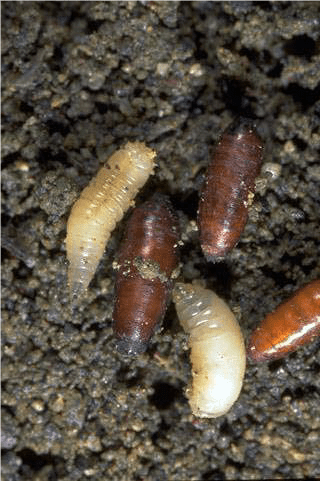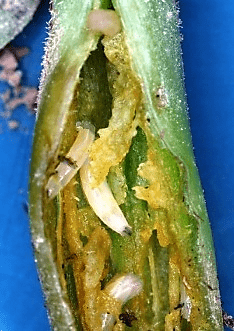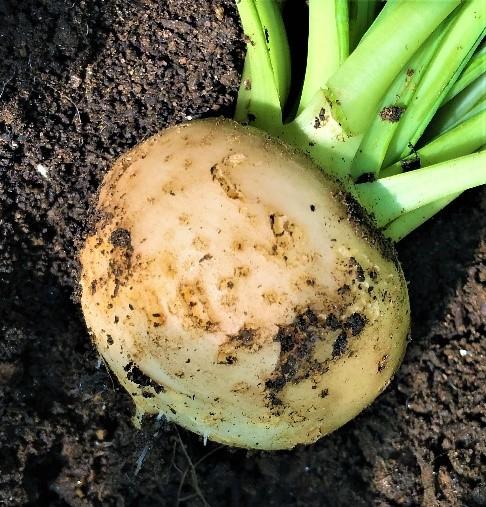Seedcorn maggot eggs are oviposited in soils with decaying plant material or manure. Onion maggot females lay eggs in soil near onion plants. Female cabbage maggot flies seek out and lay eggs on the lower portions of stems of young host seedlings or in nearby cracks in the soil. Some wild crucifers, such as yellow rocket, are important hosts for cabbage maggot and are especially important for their overwintering success; when these weeds are abundant they can lead to heavy infestations of spring crucifers. Add this weed component to the very mild winter we had and infestations are almost assured in many fields. The adults are also attracted to the organic media around the roots of transplants and germinating seeds. Within a few days the eggs hatch and the tiny maggots burrow down to the roots and into stems and begin feeding.
Larvae of seedcorn maggots attack seedlings, feeding on the developing roots and stem. Their damage is usually restricted to the early seedling stage. SCM larvae will move into small stems and move up the plant causing a swelling of the stem just above ground level, while also causing root collapse and decay. If these stems are split you usually can find the white cylindrical larvae (fig. 3). Onion or cabbage maggots inflict similar damage but usually continue to feed on the expanding bulb during later stages of growth (fig. 4). A single maggot can destroy up to 20 small seedlings. Either SCM or OM can attack onion bulbs, while SCM also can attack vegetable seeds and transplants. Complete larval development requires 2-4 weeks. Maggots then enter a pupal stage that lasts another 2-4 weeks. There are 3-4 generations per season in our area, with the most destructive being the spring and fall generations. When wilted transplants or newly emerging seedlings are inspected in the field, maggots are sometimes not found (they have already pupated), but their tell-tale damage appears as hollowed out seeds or stems and roots held together by a few strands of plant material.
Cultural Controls: Avoid planting in soils that have a great deal of non-decomposed organic matter, such as fields with manure or compost applications or a heavy cover crop or are very weedy. Rotate early season crops away from any areas that had onions or crucifers last fall. Early spring-planted crops are more likely to be damaged when the soil is too cool for rapid germination and emergence. If serious infestations are expected, wait until the soil warms up in the spring. Recently seeded or transplanted crops should be covered with floating row covers, which act as barriers against any of the root maggot flies. Do not use row covers where onions or brassicas were grown the previous year. When soil temperatures increase and maggot first-flights end, the row covers can be removed.



